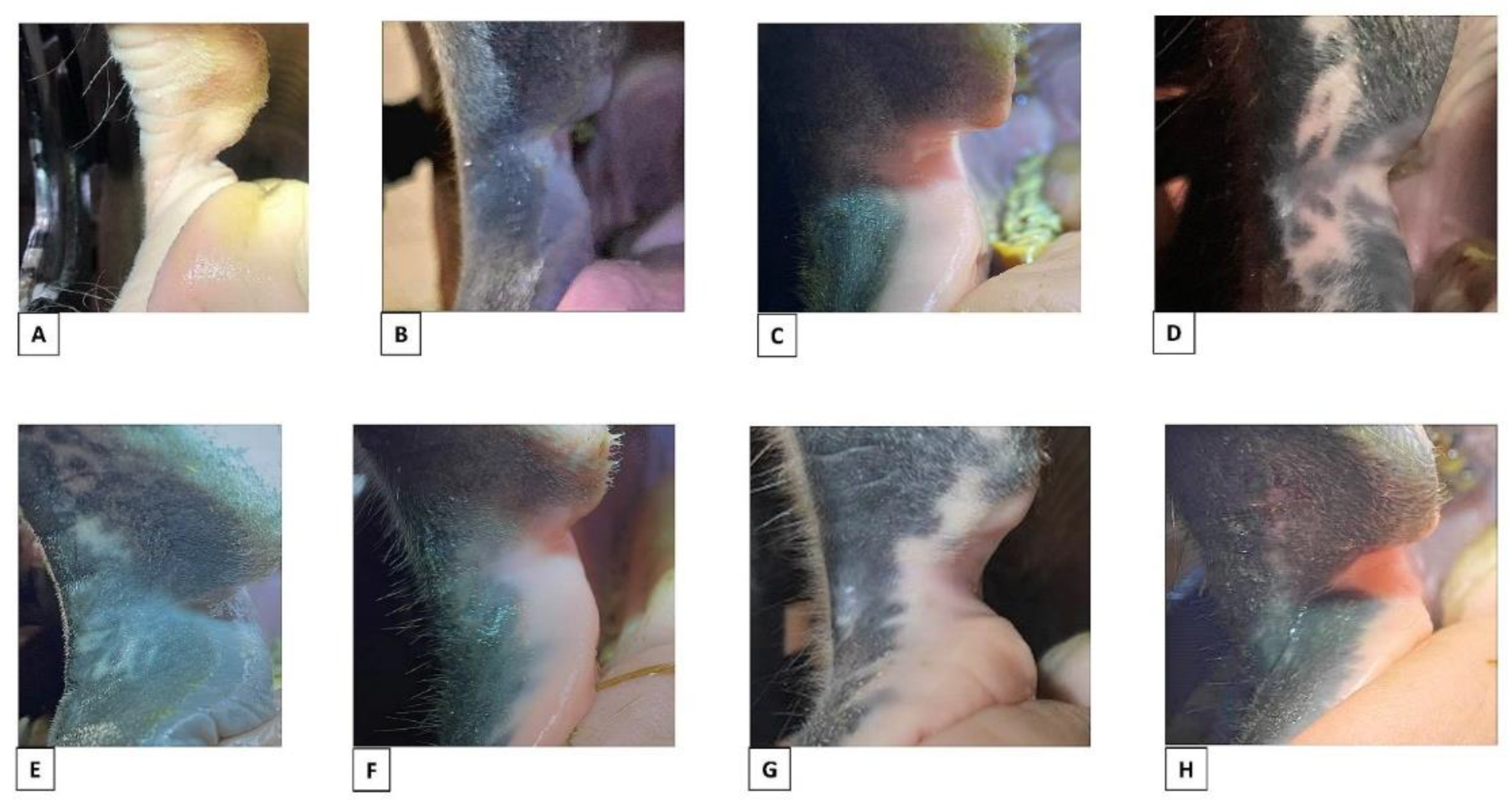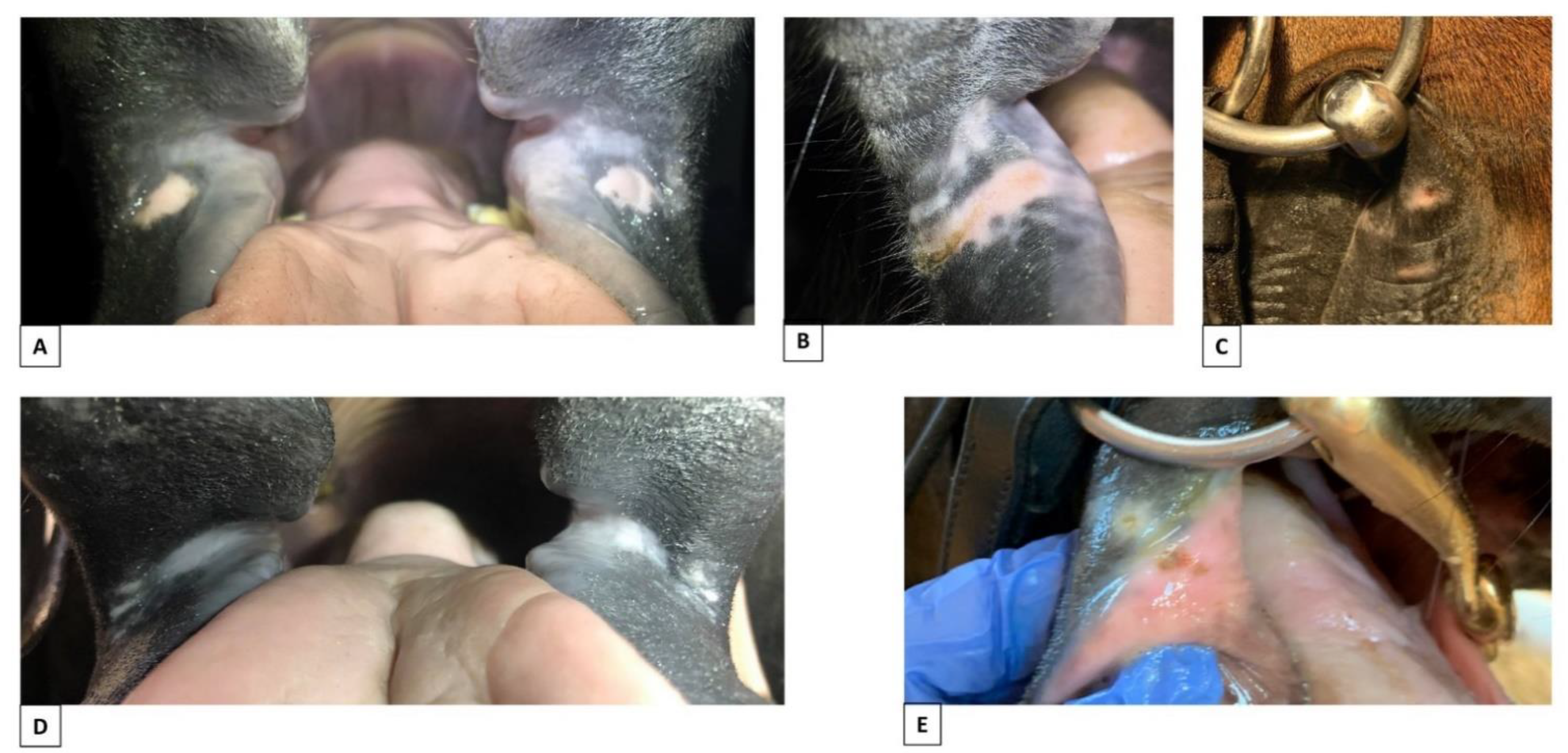Assessment of Skin and Mucosa at the Equine Oral Commissures to Assess Pathology from Bit Wear: The Oral Commissure Assessment Protocol (OCA) for Analysis and Categorisation of Oral Commissures
Abstract
:Simple Summary
Abstract
1. Introduction
2. Materials and Methods
2.1. Study Design
2.2. Analysis of Photographs
- Interruption of the natural lining (scars);
- Roughness;
- Contusion/erosion;
- Ulcer;
- Bleeding.
2.3. Description of Findings
2.3.1. Pigmentation—Naturally Occurring
- Score 0: dark pigmentation;
- Score 1–21: anatomical location of light pigmentation;
- Score 0: no, irregular, or mottled pigmentation;
- Score 1–21: anatomical location/distribution of irregular or mottled pigmentation.
2.3.2. Pigmentation—Potentially Pathological Pigment Changes
- Score 0: none;
- Scores 1–21: anatomical location/distribution of circular areas of light pigmentation;
- Score 0: none;
- Scores 1–21: anatomical location/distribution of circular areas of grey pigmentation;
- Score 0: none;
- Scores 1–21: anatomical location/distribution of linear areas of light pigmentation;
- Score 0: none;
- Scores 1–21: anatomical location/distribution of linear areas of grey pigmentation.
2.3.3. Changes in the Contours of the Mouth
- Score 0: none;
- Scores 1–21: anatomical location/distribution of healed minor wounds;
- Score 0: none;
- Scores 1–21: anatomical location/distribution of healed major wounds;
- Score 0: none;
- Scores 1–21: anatomical location/distribution of roughness.
2.3.4. Contusion/Erosion (Bruises, Red Marks)
- Score 0: none;
- Scores 1–21: anatomical location/distribution of red tissue;
- Score 0: none;
- Scores 1–21: anatomical location/distribution of pale, yellow or light red tissue;
- Score 0: none;
- Scores 1–21: anatomical location/distribution of dark red, brown or black tissue.
2.3.5. Ulcer
- Score 0: normal colour;
- Scores 1–21: anatomical location/distribution of red erythematous, tissue;
- Score 0: normal colour;
- Scores 1–21: anatomical location/distribution of greyish or thickened, unhealthy/fibrous tissue;
- Score 0: none;
- Scores 1–21: anatomical location/distribution of healthy red-pink tissue;
- Score 0: none;
- Scores 1–21: anatomical location/distribution of pale red/grey/white tissue;
- Score 0: none;
- Scores 1–21: anatomical location/distribution of dark red/brown/black tissue.
2.3.6. Bleeding
- Score 0: none;
- Scores 1–21: anatomical location/distribution of bleeding.
2.4. Statistical Analysis
3. Results
3.1. Natural Pigmentation and Potentially Pathological Pigment Change
3.1.1. Naturally Occurring Light or Mottled Pigmentation at the Commissures of the Lips (P1 and P2)
3.1.2. Naturally Occurring Light or Mottled Pigmentation (P1 and P2), Markings and Colour of the Horse Related to Potentially Pathological Pigment Changes (P3–P6)
3.1.3. Potentially Pathological Pigment Changes Related to Level of Training and Use of Horse (P3–P6)
3.2. Changes in the Contours of the Mouth (S1–S2 and S3)
3.2.1. Permanent Interruption of the Natural Lining (Scars), S1 and S2 Findings
3.2.2. Roughness, S3 Findings
3.3. Contusion/Erosion (CE1–3)
3.4. Ulcer (UE1–2 and UB1–3)
3.5. Bleeding
4. Discussion
5. Conclusions
Author Contributions
Funding
Institutional Review Board Statement
Informed Consent Statement
Data Availability Statement
Acknowledgments
Conflicts of Interest
Appendix A

References
- Anthony, D. The origin of horseback riding. Sci. Am. 1991, 265, 94–100. [Google Scholar] [CrossRef]
- Mata, F.; Johnson, C.; Bishop, C. A cross-sectional epidemiological study of prevalence and severity of bit-induced oral trauma in polo ponies and race horses. J. Appl. Anim. Welf. Sci. 2015, 18, 259–268. [Google Scholar] [CrossRef] [PubMed]
- Tell, A.; Egenvall, A.; Lundström, T.; Wattle, O. The prevalence of oral ulceration in Swedish horses when ridden with bit and bridle and when unridden. Vet. J. 2008, 178, 405–410. [Google Scholar] [CrossRef] [PubMed]
- Tuomola, K.; Mäki-Kihniä, N.; Kujala-Wirth, M.; Mykkänen, A.; Valros, A. Oral Lesions in the Bit Area in Finnish Trotters After a Race: Lesion Evaluation, Scoring, and Occurrence. Front. Vet. Sci. 2019, 6, 206. [Google Scholar] [CrossRef] [PubMed] [Green Version]
- Tuomola, K.; Mäki-Kihniä, N.; Valros, A.; Mykkänen, A.; Kujala-Wirth, M. Bit-Related Lesions in Event Horses After a Cross-Country Test. Front. Vet. Sci. 2021, 8, 651160. [Google Scholar] [CrossRef] [PubMed]
- Uldahl, M.; Clayton, H.M. Lesions associated with the use of bits, nosebands, spurs and whips in Danish competition horses. Equine Vet. J. 2019, 51, 154–162. [Google Scholar] [CrossRef] [PubMed]
- Björnsdóttir, S.; Frey, R.; Kristjansson, T.; Lundström, T. Bit-related lesions in Icelandic competition horses. Acta Vet. Scand. 2014, 56, 40. [Google Scholar] [CrossRef] [PubMed] [Green Version]
- Uldahl, M.; Bundegaard, L.; Dahl, J.; Clayton, H.M. Assessment of skin and mucosa at the equine oral commissures to assess pathology from bit wear. Animals 2022, 12, 616. [Google Scholar] [CrossRef]
- Tavares, T.S.; Meirelles, D.P.; de Aguiar, M.C.F.; Caldeira, P.C. Pigmented lesions of the oral mucosa: A cross-sectional study of 458 histopathological specimens. Oral Dis. 2018, 24, 1484–1491. [Google Scholar] [CrossRef] [PubMed]
- Chadwick, S.; Heath, R.; Shah, M. Abnormal pigmentation within cutaneous scars: A complication of wound healing. Indian J. Plast. Surg. 2012, 45, 403–411. [Google Scholar] [CrossRef] [PubMed]
- Rawlings, A.V. Ethnic skin types: Are there differences in skin structure and function? Int. J. Cosmet. Sci. 2006, 28, 79–93. [Google Scholar] [CrossRef] [PubMed]
- Clayton, H.; MacKechnie-Guire, R.; Byström, A.; Le Jeune, S.; Egenvall, A. Guidelines for the Measurement of Rein Tension in Equestrian Sport. Animals 2021, 11, 2875. [Google Scholar] [CrossRef] [PubMed]
- Tuomola, K.; Mäki-Kihniä, N.; Valros, A.; Mykkänen, A.; Kujala-Wirth, M. Risk factors for bit-related lesions in Finnish trotting horses. Equine Vet. J. 2021, 53, 1132–1140. [Google Scholar] [CrossRef] [PubMed]









| Area | Skin | Mucosa | Skin and Mucosa |
|---|---|---|---|
| A1 | 1 | 8 | 15 |
| A2 | 2 | 9 | 16 |
| A3 | 3 | 10 | 17 |
| A1 + 2 | 4 | 11 | 18 |
| A1 + 3 | 5 | 12 | 19 |
| A2 + 3 | 6 | 13 | 20 |
| A1 + 2 + 3 | 7 | 14 | 21 |
| Predictors | N | Naturally Occurring Light/Mottled Pigmentation (P1 and P2) Number (%) | Potentially Pathological Pigment Changes (P3 to P6) Number (%) | Interruption of Natural Lining (Scar) (S1 and S2) Number (%) | Roughness (S3) Number (%) |
|---|---|---|---|---|---|
| No marking | 195 | 125 (64%) | 39 (20%) | 7 (3%) | 8 (4%) |
| Marking around oral commissure | 11 | 9 (91%) | 2 (18%) | 0 | 0 |
| Dark colour body | 150 | 95 (63%) | 26 (17%) | 6 (4%) | 7 (5%) |
| Light colour body | 32 | 25 (78%) | 14 (44%) | 1 (3%) | 1 (3%) |
| Mix | 24 | 15 (63%) | 1 (4%) | 0 | 0 |
| Dressage | 77 | 48 (62%) | 16 (21%) | 3 (4%) | 4 (2%) |
| Event | 2 | 2 (100%) | 0 | 0 | 0 |
| Jump | 20 | 12 (60%) | 7 (35%) | 2 (10%) | 0 |
| Leisure | 60 | 47 (78%) | 10 (17%) | 2 (3%) | 1 (0.5%) |
| No bit/untrained | 41 | 25 (61%) | 5 (12%) | 0 | 3 (1%) |
| Trotter | 6 | 1 (17%) | 3 (50%) | 0 | 0 |
| High training | 11 | 5 (45%) | 5 (45%) | 2 (18%) | 0 |
| Low/Medium training | 154 | 105 (68%) | 31 (20%) | 5 (3%) | 5 (3%) |
| No training | 41 | 25 (61%) | 5 (12%) | 0 | 3 (7%) |
| Bit | 165 | 110 (67%) | 36 (22%) | 7 (4%) | 5 (3%) |
| No bit | 41 | 25 (61%) | 5 (12%) | 0 | 3 (7%) |
| Horse (>148 cm) | 128 | 76 (59%) | 27 (21%) | 3 (2%) | 5 (2%) |
| Icelandic | 42 | 29 (69%) | 6 (14%) | 2 (5%) | 0 |
| Pony | 36 | 30 (83%) | 8 (22%) | 2 (6%) | 3 (1%) |
| 0–4 years | 32 | 14 (44%) | 6 (19%) | 0 | 3 (1%) |
| 5–9 years | 65 | 31 (48%) | 17 (26%) | 3 (5%) | 1 (0.5%) |
| 10–14 years | 60 | 44 (73%) | 10 (17%) | 2 (3%) | 4 (2%) |
| 15–20 years | 49 | 46 (94%) | 8 (16%) | 2 (4%) | 0 |
| Variables | Natural Pigmentation (P1 and P2) | Potentially Pathological Pigment Changes (P3 to P6) | Interruption of the Natural Lining (Scars) (S1 and S2) | Roughness (S3) |
|---|---|---|---|---|
| Marking around oral commissure | 0.10 | 0.88 | 1 | 1 |
| Colour of body | 0.26 | 0.0004 (0.0003) | 0.84 | 0.74 |
| Discipline | 0.02 | 0.12 | 0.48 | 0.50 |
| Training | 0.24 | 0.04 (0.03) | 0.02 (0.03) | 0.40 |
| Bit | 0.49 | 0.20 | 0.35 | 0.32 |
| Type of horse | 0.02 | 0.06 | 0.64 | 0.15 |
| Age | 0.0001 (<0.0001) | 0.20 | 0.64 | 0.16 |
Publisher’s Note: MDPI stays neutral with regard to jurisdictional claims in published maps and institutional affiliations. |
© 2022 by the authors. Licensee MDPI, Basel, Switzerland. This article is an open access article distributed under the terms and conditions of the Creative Commons Attribution (CC BY) license (https://creativecommons.org/licenses/by/4.0/).
Share and Cite
Uldahl, M.; Bundgaard, L.; Dahl, J.; Clayton, H.M. Assessment of Skin and Mucosa at the Equine Oral Commissures to Assess Pathology from Bit Wear: The Oral Commissure Assessment Protocol (OCA) for Analysis and Categorisation of Oral Commissures. Animals 2022, 12, 643. https://doi.org/10.3390/ani12050643
Uldahl M, Bundgaard L, Dahl J, Clayton HM. Assessment of Skin and Mucosa at the Equine Oral Commissures to Assess Pathology from Bit Wear: The Oral Commissure Assessment Protocol (OCA) for Analysis and Categorisation of Oral Commissures. Animals. 2022; 12(5):643. https://doi.org/10.3390/ani12050643
Chicago/Turabian StyleUldahl, Mette, Louise Bundgaard, Jan Dahl, and Hilary Mary Clayton. 2022. "Assessment of Skin and Mucosa at the Equine Oral Commissures to Assess Pathology from Bit Wear: The Oral Commissure Assessment Protocol (OCA) for Analysis and Categorisation of Oral Commissures" Animals 12, no. 5: 643. https://doi.org/10.3390/ani12050643
APA StyleUldahl, M., Bundgaard, L., Dahl, J., & Clayton, H. M. (2022). Assessment of Skin and Mucosa at the Equine Oral Commissures to Assess Pathology from Bit Wear: The Oral Commissure Assessment Protocol (OCA) for Analysis and Categorisation of Oral Commissures. Animals, 12(5), 643. https://doi.org/10.3390/ani12050643






